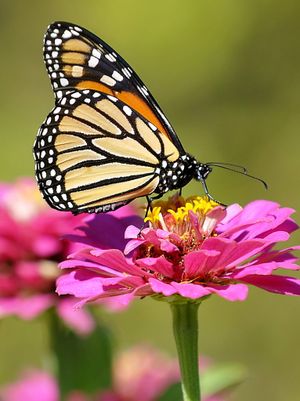Endangered status for monarch butterfly petitioned
ENDANGERED SPECIES -- A legal petition was last week to seek Endangered Species Act protection for the monarch butterfly, which a species that's declined around 90 percent in the past two decades.
The Center for Biological Diversity and Center for Food Safety as co-lead petitioners joined by the Xerces Society and monarch scientist Lincoln Brower in petitioning the U.S. Fish and Wildlife Service.
In about 20 years, these once-common iconic orange and black butterflies may have lost more than 165 million acres of habitat — an area about the size of Texas — including nearly a third of their summer breeding grounds, the petitioners said.
“Monarchs are in a deadly free fall and the threats they face are now so large in scale that Endangered Species Act protection is needed sooner rather than later, while there is still time to reverse the severe decline in the heart of their range,” said Lincoln Brower, monarch researcher and conservationist, who has been studying the species since 1954.
“The 90 percent drop in the monarch’s population is a loss so staggering that in human-population terms it would be like losing every living person in the United States except those in Florida and Ohio,” said Tierra Curry, a senior scientist at the Center for Biological Diversity.
Some experts say the butterfly’s dramatic decline is being driven by the widespread planting of genetically engineered crops in the Midwest, where most monarchs are born. The vast majority of genetically engineered crops are made to be resistant to Monsanto’s Roundup herbicide, a uniquely potent killer of milkweed, the monarch caterpillar’s only food.
"The dramatic surge in Roundup use with Roundup Ready crops has virtually wiped out milkweed plants in midwestern corn and soybean fields," the petitioners say.
“The widespread decline of monarchs is driven by the massive spraying of herbicides on genetically engineered crops, which has virtually eliminated monarch habitat in cropland that dominates the Midwest landscape,” said Bill Freese, a Center for Food Safety science policy analyst. “Doing what is needed to protect monarchs will also benefit pollinators and other valuable insects, and thus safeguard our food supply.”
Monarch butterflies are known for their spectacular multigenerational migration each year from Mexico to Canada and back. Found throughout the United States during summer months, in winter most monarchs from east of the Rockies converge in the mountains of central Mexico, where they form tight clusters on just a few acres of trees. Most monarchs west of the Rockies migrate to trees along the California coast to overwinter.
In a media release, the petitioners continued:
The population has declined from a recorded high of approximately 1 billion butterflies in the mid-1990s to only 35 million butterflies last winter, the lowest number ever recorded. The overall population shows a steep and statistically significant decline of 90 percent over 20 years. In addition to herbicide use with genetically engineered crops, monarchs are also threatened by global climate change, drought and heat waves, other pesticides, urban sprawl, and logging on their Mexican wintering grounds. Scientists have predicted that the monarch’s entire winter range in Mexico and large parts of its summer range in the states could become unsuitable due to changing temperatures and increased risk of drought, heat waves and severe storms.
Monarchs need a very large population size to be resilient to threats from severe weather events and predation. Nearly half of the overwintering population in Mexico can be eaten by bird and mammal predators in any single winter; a single winter storm in 2002 killed an estimated 500 million monarchs — 14 times the size of the entire current population.
“We need to take immediate action to protect the monarch so that it doesn’t become another tragic example of a widespread species being erased because we falsely assumed it was too common to become extinct,” said Sarina Jepsen, endangered species director at the Xerces Society. “2014 marks the 100th anniversary of the extinction of the passenger pigeon, which was once so numerous no one would ever have believed it was at risk of extinction. History demonstrates that we cannot afford to be complacent about saving the monarch.”
“The purpose of the Endangered Species Act is to protect species like the monarch, and protect them, now, before it’s too late,” said George Kimbrell, senior attorney at the Center for Food Safety. “We’ve provided FWS a legal and scientific blueprint of the urgently needed action here.”
“The monarch is the canary in the cornfield, a harbinger of environmental change that we’ve brought about on such a broad scale that many species of pollinators are now at risk if we don’t take action to protect them,” said Brower, who has published hundreds of scientific studies on monarchs.

